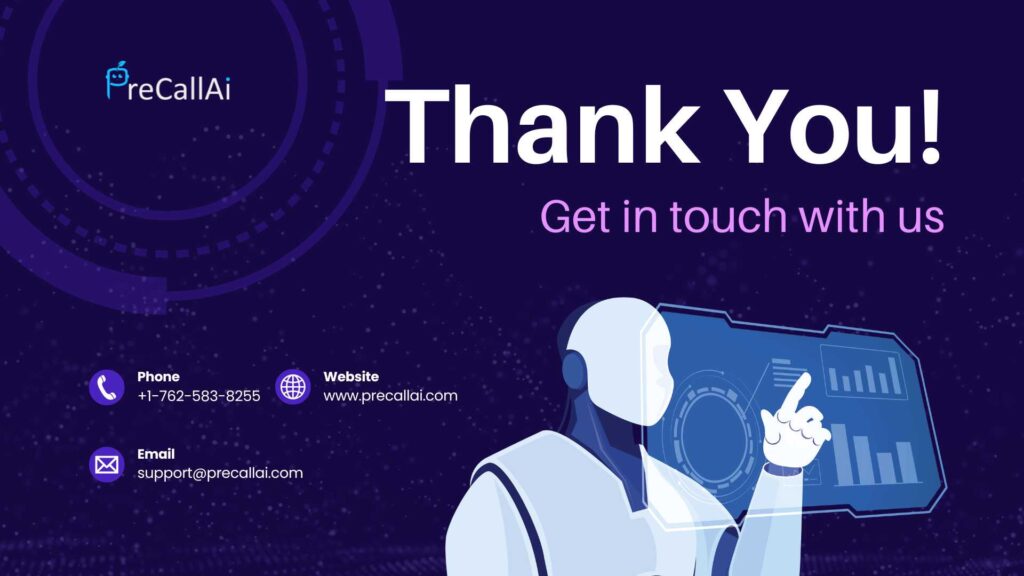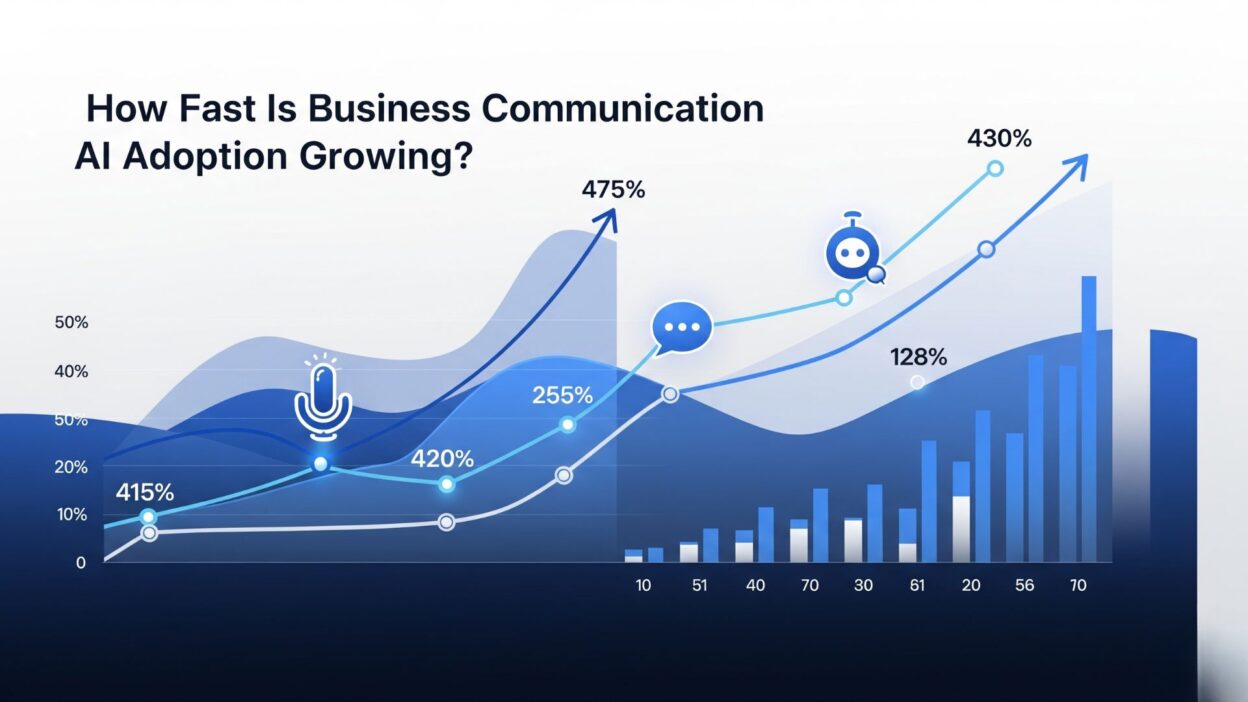TL;DR Business communication AI adoption is transforming the corporate landscape at unprecedented speed. Companies across industries are discovering the revolutionary potential of artificial intelligence in streamlining their communication processes. The digital transformation wave has accelerated dramatically over the past few years. Organizations are recognizing that traditional communication methods no longer meet the demands of modern business environments.
Table of Contents
The global business communication AI market is experiencing explosive growth. Industry analysts project significant expansion in the coming years. This growth stems from businesses seeking more efficient ways to connect with customers and stakeholders. Voice bots, chatbots, and automated communication systems are becoming essential tools for competitive advantage.
PreCallAI represents the forefront of this technological revolution. Our advanced voice bot technology automates phone conversations with remarkable accuracy and efficiency. Businesses using PreCallAI report substantial improvements in customer engagement and operational productivity.
Current State of Business Communication AI Market
Market Size and Growth Projections
Business communication AI adoption has reached a critical tipping point. The global market for AI-powered communication tools was valued at $8.2 billion in 2023. Experts predict this figure will reach $24.7 billion by 2028. This represents a compound annual growth rate of 24.6%.
The rapid expansion reflects businesses’ urgent need for scalable communication solutions. Traditional phone systems and manual processes cannot handle increasing customer demands. Companies are investing heavily in AI-driven platforms to maintain competitive positioning.
Small and medium enterprises are driving significant portions of this growth. These businesses recognize that business communication AI adoption levels the playing field with larger competitors. Cost-effective AI solutions enable smaller companies to provide enterprise-level customer service capabilities.
Industry Vertical Adoption Patterns
Healthcare organizations are leading business communication AI adoption across multiple use cases. Hospitals and clinics use AI voice bots for appointment scheduling and patient follow-ups. These systems reduce administrative burdens while improving patient satisfaction scores.
Financial services companies have embraced automated communication platforms for customer support. Banks deploy AI-powered systems to handle routine inquiries and transaction processing. This automation allows human agents to focus on complex financial advisory services.
Retail businesses leverage business communication AI adoption for order management and customer service. E-commerce platforms integrate voice bots to handle product inquiries and order tracking. These systems operate 24/7 without requiring additional staffing costs.
Real estate agencies utilize AI communication tools for lead qualification and property inquiries. Automated systems can schedule property viewings and provide basic information to potential buyers. This automation increases agent productivity while ensuring prompt customer responses.
Technology Infrastructure Driving Growth
Cloud Computing and Scalability
Cloud-based infrastructure enables rapid business communication and AI adoption across organizations of all sizes. Companies no longer need extensive on-premise hardware to deploy sophisticated AI communication systems. Cloud platforms provide scalable solutions that grow with business needs.
Modern AI communication platforms integrate seamlessly with existing business systems. CRM platforms, help desk software, and customer databases connect directly with AI voice bots. This integration creates comprehensive customer communication ecosystems.
The accessibility of cloud-based AI solutions has democratized advanced communication technology. Small businesses can now access enterprise-grade AI capabilities without significant upfront investments. This democratization accelerates overall market adoption rates.
Natural Language Processing Advances
Recent breakthroughs in natural language processing have revolutionized business communication AI adoption capabilities. Modern AI systems understand context, emotion, and intent with remarkable accuracy. These improvements make automated conversations feel more natural and engaging.
Voice recognition technology has achieved near-human accuracy levels in controlled environments. AI systems can now handle complex conversations with minimal human intervention. This accuracy improvement drives greater business confidence in automated communication solutions.
Multilingual support capabilities expand the reach of business communication AI adoption globally. Companies can deploy single AI platforms that communicate effectively across different languages and cultural contexts. This capability is particularly valuable for international businesses.
Machine Learning and Continuous Improvement
Machine learning algorithms enable AI communication systems to improve performance over time. Each customer interaction provides data that enhances future conversation quality. This continuous improvement cycle increases system effectiveness and user satisfaction.
Predictive analytics capabilities help businesses anticipate customer communication needs. AI systems can identify patterns in customer behavior and proactively address common concerns. This predictive approach improves customer experience while reducing support costs.
Sentiment analysis features allow AI systems to detect customer emotions during conversations. Systems can escalate calls to human agents when customers express frustration or complex concerns. This intelligent routing ensures appropriate handling of sensitive situations.
Business Benefits Driving Adoption
Cost Reduction and Operational Efficiency
Business communication AI adoption delivers immediate cost savings through automation of routine tasks. Companies report 40-60% reduction in customer service operational costs after implementing AI communication systems. These savings come from reduced staffing needs and improved process efficiency.
AI systems handle high volumes of simultaneous conversations without additional resource requirements. A single AI voice bot can manage hundreds of concurrent calls. This scalability eliminates the need for large customer service teams during peak periods.
Automated systems operate continuously without breaks, holidays, or sick leave. This 24/7 availability improves customer satisfaction while reducing overtime costs. Businesses can provide consistent service levels regardless of time zones or business hours.
Enhanced Customer Experience
Business communication AI adoption significantly improves response times for customer inquiries. AI systems provide instant responses to common questions and concerns. Customers no longer wait in phone queues or for email responses.
Personalization capabilities allow AI systems to tailor conversations based on customer history and preferences. These personalized interactions increase customer satisfaction and loyalty. AI can access customer data instantly to provide relevant, contextual responses.
Consistency in communication quality becomes achievable through AI automation. Every customer receives the same high-quality service experience regardless of which system handles their inquiry. This consistency builds trust and brand reputation.
Data Collection and Analytics
Business communication AI adoption generates valuable customer interaction data for analysis. Companies gain insights into customer preferences, pain points, and behavior patterns. This data drives product development and service improvement initiatives.
Real-time analytics capabilities provide immediate visibility into communication performance metrics. Managers can monitor call resolution rates, customer satisfaction scores, and system efficiency. This visibility enables rapid optimization and problem resolution.
Predictive modeling based on communication data helps businesses forecast customer needs and market trends. Companies can proactively develop solutions for emerging customer requirements. This predictive capability provides competitive advantages in dynamic markets.
Industry-Specific Adoption Trends
Healthcare Sector Transformation
Healthcare organizations are experiencing rapid business communication AI adoption across patient communication workflows. Medical practices use AI systems for appointment reminders, prescription notifications, and follow-up care instructions. These automated communications improve patient compliance and health outcomes.
Telemedicine platforms integrate AI voice bots for initial patient screening and symptom assessment. These systems gather preliminary information before connecting patients with healthcare providers. This screening process improves appointment efficiency and provider productivity.
Insurance verification and prior authorization processes benefit significantly from AI automation. Healthcare offices use AI systems to handle routine insurance inquiries and authorization requests. This automation reduces administrative burdens on medical staff.
Financial Services Innovation
Banking institutions leverage business communication AI adoption for fraud detection and customer notification systems. AI voice bots can instantly contact customers about suspicious account activity. These rapid notifications help prevent financial losses and improve security.
Investment firms use AI communication systems for market updates and portfolio notifications. Clients receive personalized investment alerts and market analysis through automated voice calls. This service adds value while reducing operational costs.
Credit card companies deploy AI systems for payment reminders and account management services. Automated systems handle routine account inquiries and payment processing. This automation improves customer service while reducing call center costs.
Retail and E-commerce Evolution
Online retailers integrate business communication AI adoption into order management and customer support workflows. AI systems handle order confirmations, shipping notifications, and delivery updates. These automated communications keep customers informed throughout the purchase process.
Customer service chatbots and voice bots handle product inquiries, returns, and technical support issues. These systems provide instant assistance while human agents focus on complex problems. This approach improves overall customer satisfaction scores.
Inventory management systems use AI communication to notify customers about product availability and restock updates. Automated notifications help maintain customer engagement and drive repeat purchases. This proactive communication strategy increases sales conversion rates.
Regional Adoption Patterns
North American Market Leadership
North America leads global business communication AI adoption rates across multiple industry sectors. United States companies invest heavily in AI communication infrastructure to maintain competitive advantages. The mature technology ecosystem supports rapid deployment of advanced AI solutions.
Canadian businesses follow similar adoption patterns with focus on bilingual communication capabilities. AI systems must handle both English and French communications effectively. This requirement drives development of sophisticated multilingual AI platforms.
Government agencies in North America are beginning to explore business communication AI adoption for citizen services. Public sector applications include tax assistance, benefits information, and general inquiry handling. These implementations improve service delivery while reducing operational costs.
European Market Development
European businesses approach business communication AI adoption with emphasis on data privacy and regulatory compliance. GDPR requirements influence AI system design and deployment strategies. Companies prioritize solutions that meet strict European data protection standards.
Financial services organizations in Europe lead business communication AI adoption within regulatory frameworks. Banks and insurance companies implement AI systems while maintaining compliance with financial regulations. These implementations demonstrate successful integration of AI technology with regulatory requirements.
Manufacturing companies across Europe use AI communication systems for supply chain coordination and customer updates. These systems handle order status inquiries and delivery scheduling communications. This automation improves supply chain visibility and customer satisfaction.
Asia-Pacific Growth Opportunities
Asia-Pacific markets show tremendous potential for business communication AI adoption expansion. Rapidly growing economies create demand for scalable communication solutions. Businesses in this region seek cost-effective ways to serve expanding customer bases.
Technology companies in Asia-Pacific develop innovative AI communication platforms for local and global markets. These companies often focus on multilingual capabilities and cultural adaptation features. Their innovations drive global advancement in AI communication technology.
E-commerce platforms in Asia-Pacific integrate business communication AI adoption into customer service and logistics operations. High transaction volumes require automated systems to maintain service quality. These implementations demonstrate AI scalability in high-volume environments.
Challenges and Barriers to Adoption
Technical Implementation Hurdles
Legacy system integration presents significant challenges for business communication AI adoption initiatives. Many companies operate older communication infrastructures that resist modern AI integration. These technical barriers require careful planning and substantial investment to overcome.
Staff training requirements can slow business communication AI adoption timelines. Employees need education about AI system capabilities and proper usage protocols. Comprehensive training programs ensure successful implementation and user acceptance.
Data quality issues impact AI system performance and adoption success rates. Poor data inputs result in suboptimal AI outputs and user frustration. Companies must invest in data cleaning and standardization before implementing AI communication systems.
Regulatory and Compliance Considerations
Privacy regulations vary significantly across different jurisdictions and industries. Business communication AI adoption must comply with local data protection requirements. Companies need legal expertise to navigate complex regulatory landscapes.
Industry-specific compliance requirements add complexity to AI implementation projects. Healthcare, financial services, and other regulated industries have strict communication standards. AI systems must meet these standards while providing desired automation benefits.
Cross-border communication creates additional regulatory challenges for global businesses. Different countries have varying requirements for automated customer communications. Companies must ensure compliance across all operational jurisdictions.
Cost and Resource Allocation
Initial implementation costs can be substantial for comprehensive business communication AI adoption programs. Companies must budget for software licensing, integration services, and staff training. These upfront investments require careful financial planning and executive support.
Ongoing maintenance and system updates require dedicated resources and expertise. AI systems need continuous monitoring and optimization to maintain performance levels. Companies must allocate technical resources for long-term system management.
Return on investment timelines vary significantly based on implementation complexity and business requirements. Some organizations see immediate benefits while others require longer periods to realize full value. Realistic expectation setting is crucial for adoption success.
Future Outlook and Predictions
Technological Advancement Trajectories
Artificial intelligence capabilities will continue advancing at accelerating rates in coming years. Business communication AI adoption will benefit from improved natural language processing and conversational abilities. These advancements will make AI interactions increasingly indistinguishable from human conversations.
Integration with emerging technologies like augmented reality and Internet of Things devices will expand AI communication capabilities. Future systems will handle multi-modal interactions across various communication channels. This integration will create seamless customer experience ecosystems.
Edge computing developments will enable more responsive and efficient AI communication systems. Local processing capabilities will reduce latency and improve conversation quality. These improvements will drive higher adoption rates across latency-sensitive applications.
Market Growth Projections
Industry analysts predict continued explosive growth in business communication AI adoption over the next decade. Market values could exceed $75 billion by 2030 based on current trajectory patterns. This growth will be driven by expanding use cases and technological improvements.
Small and medium enterprises will represent the largest growth segment for AI communication adoption. These businesses will increasingly access enterprise-grade AI capabilities through cloud-based platforms. This democratization will accelerate overall market expansion.
Vertical market specialization will create opportunities for focused AI communication solutions. Industry-specific platforms will address unique sector requirements and regulatory needs. This specialization will drive deeper adoption within targeted markets.
Emerging Use Cases and Applications
Voice commerce integration will become a significant driver of business communication AI adoption. Customers will complete purchases through AI-powered voice conversations. This capability will transform e-commerce and retail customer interactions.
Predictive customer service will leverage AI communication systems to address issues before customers contact support. Proactive communication based on usage patterns and predictive analytics will improve customer satisfaction. This approach will differentiate leading companies from competitors.
Multi-language real-time translation will eliminate communication barriers for global businesses. AI systems will facilitate conversations between customers and businesses speaking different languages. This capability will expand market reach for companies of all sizes.
Strategic Recommendations for Businesses
Assessment and Planning
Companies should conduct comprehensive assessments of current communication processes before implementing AI solutions. Understanding existing workflows and pain points guides effective AI system selection. This assessment ensures alignment between technology capabilities and business needs.
Pilot programs provide valuable insights for larger business communication AI adoption initiatives. Starting with limited scope implementations allows companies to learn and adjust strategies. Successful pilots build organizational confidence and support for broader deployments.
Cross-functional team formation ensures successful AI communication implementation projects. Teams should include technical staff, customer service representatives, and business stakeholders. This collaborative approach addresses multiple perspectives and requirements.
Implementation Best Practices
Gradual rollout strategies minimize risks associated with business communication AI adoption programs. Companies should phase implementations across different communication channels and use cases. This approach allows for learning and optimization throughout the deployment process.
Change management programs help employees adapt to AI-enhanced communication workflows. Training and support systems ensure staff can work effectively with new AI tools. Successful change management increases adoption success rates and user satisfaction.
Performance monitoring and optimization processes maximize value from AI communication investments. Regular analysis of system performance and customer feedback drives continuous improvement. This ongoing optimization ensures sustained benefits from AI adoption.
Read More: What Are Cloud Phone AI Solutions Architecture Benefits?
Conclusion

Business communication AI adoption represents a fundamental shift in how organizations interact with customers and stakeholders. The rapid growth in this market reflects the substantial benefits that AI-powered communication systems provide. Companies across various industries are discovering that AI automation enhances efficiency, reduces costs, and improves customer experiences.
The technology infrastructure supporting AI communication continues to advance rapidly. Cloud computing, natural language processing, and machine learning improvements make AI systems increasingly capable and accessible. These technological developments remove barriers to adoption while expanding possible use cases.
Future growth prospects for business communication AI adoption remain extremely positive. Expanding market opportunities, technological improvements, and proven business benefits will drive continued expansion. Companies that embrace AI communication technology today position themselves for competitive advantages in tomorrow’s marketplace.
PreCallAI stands ready to help businesses navigate this transformation successfully. Our advanced voice bot technology provides the foundation for effective AI communication strategies. Contact us today to discover how PreCallAI can accelerate your business communication AI adoption journey.





